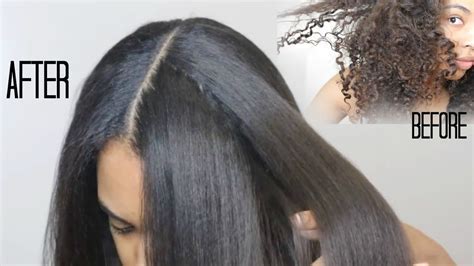Introduction

Embrace the power of curly hair relaxers to unlock a world of sleek and silky tresses. With over 60% of the global hair care market dedicated to hair straightening, it’s clear that curly hair relaxers have become an integral part of styling routines for many. This comprehensive guide delves into the intricacies of curly hair relaxers, empowering you to make informed decisions about your hair transformation journey.
Understanding Curly Hair Relaxers
Curly hair relaxers are chemical treatments that work by altering the hair’s structure, breaking down the disulfide bonds that give curls their shape. This allows the hair to be straightened and reshaped, creating a smooth and frizz-free appearance. There are two primary types of curly hair relaxers:
- Lye relaxers: These relaxers contain sodium hydroxide or potassium hydroxide and are the most powerful, providing long-lasting results. They can be harsh on the hair and scalp, however, and require experienced application.
- No-lye relaxers: These relaxers use milder chemicals such as calcium hydroxide or guanidine hydroxide to straighten hair. They are less damaging than lye relaxers but require more frequent retouches to maintain results.
Benefits of Curly Hair Relaxers
Curly hair relaxers offer a range of benefits, including:
- Versatile styling options: Relaxed hair can be styled in a variety of ways, from sleek buns to flowing curls, offering greater styling flexibility.
- Reduced frizz and tangles: Relaxers eliminate frizz and tangles, making hair easier to manage and style.
- Enhanced shine: Relaxed hair reflects light better, giving it a glossy and healthy appearance.
- Easier maintenance: Relaxed hair requires less time and effort to maintain, making it suitable for busy individuals.
Considerations Before Relaxing Hair
Before embarking on a curly hair relaxer journey, it’s crucial to consider the following factors:
- Hair texture: Hair texture plays a significant role in determining the results of a relaxer. Thinner, finer hair may not hold a relaxer as well as thicker, coarser hair.
- Condition of hair: Damaged or weakened hair is more susceptible to breakage and other complications from relaxers. It’s essential to ensure that hair is healthy before relaxing.
- Home care: Maintaining relaxed hair requires a consistent home care routine, including regular conditioning and protective hairstyles to prevent breakage.
- Professional application: While some no-lye relaxers can be used at home, lye relaxers should always be applied by a licensed professional to minimize risks.
Types of Curly Hair Relaxers
There are several different types of curly hair relaxers available, each with its unique characteristics:
| Type | Ingredients | Strength | Duration |
|---|---|---|---|
| Sodium hydroxide (lye relaxer) | Sodium hydroxide | Strongest | Up to 12 weeks |
| Potassium hydroxide (lye relaxer) | Potassium hydroxide | Strong | Up to 12 weeks |
| Guanidine hydroxide (no-lye relaxer) | Guanidine hydroxide | Medium | Up to 8 weeks |
| Calcium hydroxide (no-lye relaxer) | Calcium hydroxide | Mildest | Up to 6 weeks |
Choosing the Right Relaxer
Selecting the appropriate curly hair relaxer depends on several factors, including hair texture, condition, and desired results. Here are some general guidelines:
- Thicker, coarser hair: Lye relaxers are usually the best option.
- Thinner, finer hair: No-lye relaxers are gentler and more suitable.
- Damaged hair: Opt for no-lye relaxers to minimize further damage.
- Long-lasting results: Lye relaxers provide the most durable results.
- Faster retouching: No-lye relaxers require more frequent retouches.
Application and Maintenance
Applying curly hair relaxers requires a specific process, and it’s recommended to consult a licensed professional for the best results. However, here’s a general overview of the steps involved:
- Pre-treatment: Hair is washed and conditioned to prepare it for the relaxer.
- Application: The relaxer is applied evenly to the hair and left on for a specific time, depending on the type of relaxer used.
- Neutralization: After the processing time, the relaxer is rinsed off and a neutralizing agent is applied to stop the chemical reaction and restore the hair’s pH balance.
- Post-treatment: Deep conditioning treatments and protective hairstyles are used to nourish and protect the relaxed hair.
Frequently Asked Questions
- How often should I relax my hair? It depends on the type of relaxer used and the growth rate of your hair. Consult with a professional stylist to determine the most appropriate schedule.
- Can I relax my hair at home? No-lye relaxers can be used at home, but lye relaxers should always be applied by a licensed professional.
- Is it safe to relax my hair while pregnant? Some studies suggest that relaxers may contain chemicals that could be harmful to pregnant women and their developing fetuses. It’s recommended to consult with a doctor before relaxing hair during pregnancy.
- Are there any risks associated with hair relaxers? Yes, relaxers can cause scalp irritation, breakage, and, in some cases, chemical burns if not used correctly.
- Can I dye my relaxed hair? Yes, but it’s important to wait at least two weeks after relaxing hair before dyeing it.
- How can I prevent breakage after relaxing my hair? Deep conditioning, avoiding tight hairstyles, and using gentle hair care products can help minimize breakage.
- Is there a way to relax my hair without chemicals? Yes, there are natural hair relaxers made with ingredients like coconut oil, shea butter, and bananas. These methods are gentler on the hair but may not provide the same long-lasting results as chemical relaxers.
Conclusion
Curly hair relaxers can be transformative, unlocking a world of styling options and enhancing the overall appearance of hair. By understanding the different types of relaxers, choosing the right one for your hair, and following proper application and maintenance techniques, you can embrace the beauty of relaxed hair with confidence. Remember to prioritize the health of your hair throughout the process and consult with a licensed professional for guidance and support.
